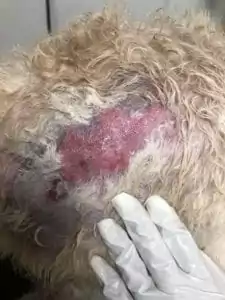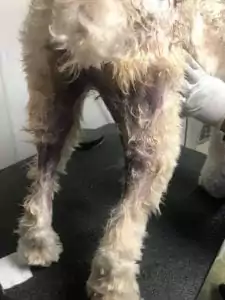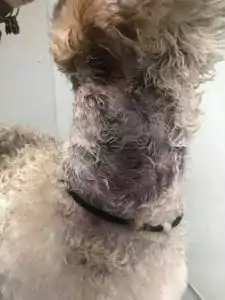Dogs lick. They lick to drink water, eat food, show affection, and often themselves. Sometimes this licking habit can lead to unwanted conditions such as Moist Dermatitis, a.k.a hot spots.
Hot spots are a very common condition that is caused by self-inflicted trauma. They are more common in dogs with longer hair and prevalent in hot, humid weather.

What are Hot spots on dogs?
Hot spots are considered surface pyoderma. Surface pyoderma is when only the superficial layers of the skin are involved. This pyoderma often comes with a secondary bacterial infection from trauma.
It’s important to consider all the defense mechanisms of the skin when educating yourself on hot spots. The skin is designed to prevent infection, but infection can still easily occur. The following list shows how the skin protects against pathogenic bacteria:
- Hair coat- your dog’s first line of defense in preventing superficial grazes or cuts.
- Epidermal turnover- when the skin is breached, brand new and healthy cells will form a covering layer.
- Stratum corneum– this area is packed tightly with epithelial cells (the thin membrane that lines and covers many areas of a dog’s organs, tissues, and glands) that help prevent invading organisms from proceeding any further.
- Epidermal lipids are used for skin surface protection, for example, when crusts form.
- Sebum (antibacterial fatty acids)- produced within the sebaceous glands that form to drown bacteria
- Immunoglobulins (antibodies)
- Interferon (proteins that are apart of natural immune system defense)
- Normal non-pathogenic flora- your dog’s normal flora will help fight off pathogenic flora keeping it from breaching the surface to cause infection.
What does a hot spot on a dog look like?
Hot spots can occur on any part of your dog. They are often swollen, red, and can be crusty looking. They are often painful and can lead to infection if not taken care of. They are a common condition resulting from self-trauma from licking, biting, and or scratching.
Hot spots are hard to stop because they create a vicious cycle. Your dog will use licking and biting to soothe the area but will also further damage to their skin.
What causes hot spots on dogs?
Hot spots are usually secondary conditions that are self-inflicted. Many primary reasons can cause a dog’s skin to become irritated. Some common underlying problems that may lead to them are:
- Allergic skin diseases
- Ectoparasites (fleas/ticks/mites)
- Otitis Externa (ear infections)
- Anal sac disease
- Dirty/matted hair coat
- Foreign body from a stick/twig
- Boredom/Stress
- Wet/moist hair from heat/swimming
Any of these reasons may cause your dog to start to lick and bite an infected area. Once the site is inflamed, and irritated bacteria can find its way in. Infection is likely to occur at this point, making it itchier.

Clinical Signs of Hot Spots
There are a few telltale signs of hot spots. They include:
- Pruritus (itching)
- Erythema (redness that often grows in size as trauma occurs)
- Edema (swelling)
- Sero-purulent exudate (a mixture of serum and pus, causing yellow crust along the outsides where it interferes with the hair)
- Pain– sometimes, orthopedic pain will cause a dog to lick the area in order to self-soothe
Treatment of Hot Spots on dogs
Treating the hot spot will depend on the location and the severity of it. The primary issue should be addressed to stop hot spots from repeating. The hair around the hot spot should be clipped and removed. It is essential to be careful when clipping to avoid further irritation to the area; this would only perpetuate the issue.
Cleaning the hot spot is important to remove any bacteria or fungus that is present on the surface. An antiseptic, antifungal, antibacterial solution such as chlorhexidine (diluted) should be used to gently clean the area.
If the hot spot is mild, then topical lotions alone can be applied. If severe, then steroids, along with topical medications, should be used. If the infection is present, then antibiotics will also have to be administered. It is also wise to make sure your dogs are being given monthly flea and tick preventatives. If fleas or any other type of ectoparasite is suspected, then medications to kill and prevent them should be presented at the time of diagnosis.

How to prevent hot spots on dogs?
Depending on what is causing your dog’s hot spot will determine how you should prevent them in the future. Of course, any of the primary causes can strike at any point, so it’s best to know how to avoid all of them.
Let’s start with boredom and stress. Knowing your dog’s behavioral traits will help you notice when your dog is suffering. Keeping your dog occupied with exercise or their favorite toy can alleviate their energy. If the stress and anxiety cannot be managed by at-home care, then it is best to speak to your veterinarian.
Of course, suppose any of the diseases (ear infection, allergic dermatitis, anal sac disease) are the primary issue. In that case, your veterinarian will have to prescribe treatment while concurrently treating the hot spot. Keeping your dog’s hair coat well maintained and cleaned to avoid matts that can help prevent irritation.

Essential fatty acids or OMEGA 3s can be given to your dog as well to promote healthy skin and coat. If your dog likes to swim, then make sure you cleanse their coat well after swimming and dry off to avoid moisture from being trapped.
If a foreign body is expected, then it is best to have your veterinarian check it out. Giving and receiving a thorough history will help decide the best course of action in the treatment and prevention of hot spots.
Summary
Even though hot spots are common, there are thankfully many ways to treat them. Even though at-home treatment can be done, it is best to seek professional help.
Many times staying ahead of the issue can help in the rate it is cured. Hot spots usually require multiple treatments that cannot be provided without seeing your veterinarian. Staying on top of your dog’s behaviors and being savvy to any licking can help keep hot spots away.

